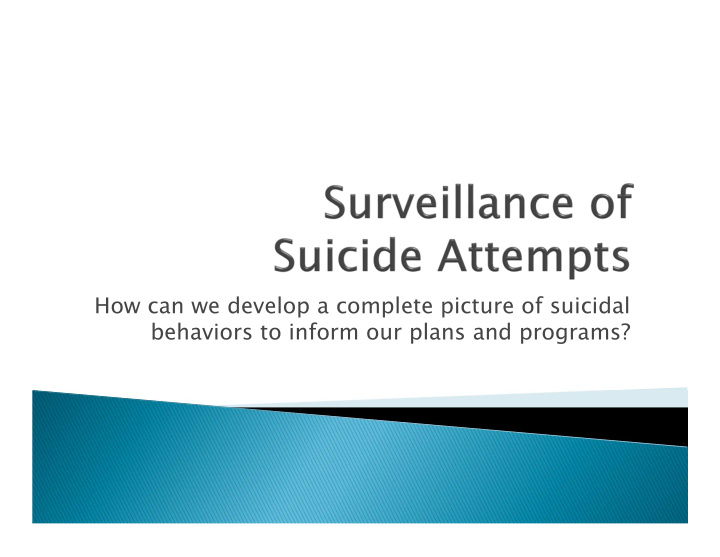



How can we develop a complete picture of suicidal behaviors to inform our plans and programs?
Data and Surveillance Task Force recommendation to the NAASP Executive Committee Questions from local programs about how to access attempt data Non-fatal surveillance task force subcommittee
And why do we do it?
“…the ongoing systematic collection, analysis, and interpretation of outcome- specific data… for use in planning, implementation, and evaluation of public health practice.” Steven Thacker
All organized measures (whether public or private) to prevent disease, promote health, and prolong life among the population as a whole. Monitoring and diagnosing thing health concerns of entire communities and promoting healthy practices and behaviors to ensure that populations stay healthy. Population Health
Estimate magnitude of a problem in the population at risk Understand the natural history of a disease or injury Detect outbreaks or epidemics Document the distribution and spread of a health event Evaluate control strategies Identify research needs Facilitate planning
Typically, suicide mortality surveillance WHY?
Why? Est. 160.4/100,000 treated in EDs in 2013 can provide a much richer and more informed understanding of local patterns of suicidal behavior
Why not?
“If you don’t know where you’re going, any road will get you there.” Lewis Carroll
Inspired by CDC technical packages Meant to compliment the state-specific “toolkits” released by SAMHSA last fall Meant to be specific, straightforward, simple (but not simplistic)
Compilation of a core set of strategies to achieve and sustain substantial reductions in a specific risk factor or outcome Help communities and states prioritize prevention activities based on the best available evidence.
Usable and useful document! ◦ High graphic, easy to read content ◦ Lots of examples ◦ Lots of links to resources
Our goal is not to do the work for you, but to get you moving in the right direction from the start and give you the tools to get where you need to go.
1. facts or information used to calculate, analyze or plan 2. factual information (as measurements or statistics) used as a basis for reasoning, discussion, or calculation
Need to be very specific in what questions you need answered? ◦ Numbers? ◦ Demographic profile? ◦ Catchment area? ◦ Where identified? ◦ Preceding and/or precipitating circumstances? ◦ ??????? Turn key info. into goals define key questions Nice Nice –to-know vs. Need Need -to-know
State or local plan as a source Systematically “profile” your community on suicide event rates, injury mechanisms, and context and risk factors Community Health Needs Assessment ◦ Look at risk and protective factors ◦ Demographic, economic, geographic variables ◦ Local, state, national extant data sources ◦ Key informant interviews
What else do programs need to know about defining the question?
Common sources What do you need to know about them? Do you know what ICD-10 codes are? Known barriers (and solutions!)
Uncommon sources Barriers and solutions
Data analysis Interpretation of findings
Turn your answers into solutions
Email me your contact info. with the subject I’m in! Smithp40@michigan.gov Provide examples; review a draft; ask questions; other things you need to know; random thoughts that pop into your head after you leave here; etc., etc., etc.
Recommend
More recommend